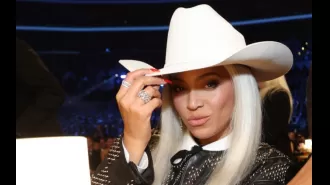The "Bond Girl Curse" may harm actresses' careers, revealing the reality behind their roles as James Bond's love interests.
Is the curse simply a myth or could it be something even more sinister?
August 17th 2024.

Have you ever heard of the Bond Girl Curse? It's a topic that has sparked much debate and discussion among movie fans. The James Bond franchise is known for its intricate history, but perhaps one of the most challenging aspects to understand is the recurring trope of the Bond Girl. And on top of that, there is also the infamous 'curse' that seems to plague the actresses who have played Bond's love interests.
The idea of a curse affecting those who take on the role of a Bond Girl has been around since the beginning, and it continues to haunt the franchise even as more well-known actresses step into these roles. But as we look towards a new era of James Bond and consider how the character fits into our ever-changing culture, it's time to delve into this pervasive myth and separate fact from fiction.
So what exactly is the Bond Girl Curse? In Hollywood, it is a widely believed belief that accepting a role as a romantic female lead in a James Bond film is a surefire way to stall your career. For years, actresses hesitated to take on these roles out of fear of becoming a victim of the curse. But the curse is not just about career setbacks. Many associate the often tragic fates of Bond's love interests with real-life misfortune.
In essence, the curse suggests that once an actress becomes a Bond Girl, she is forever stuck with that identity. And the bad luck that her character faces in the film might even follow her into her personal life. Take Tanya Roberts, for example. She played the Bond Girl in A View to Kill in 1985, and after that, she was never offered another leading role. She believed that she was reduced to being an accessory to a leading man, rather than being recognized as a leading woman in her own right.
In a 2015 interview, Roberts revealed, "I sort of felt like every girl who had ever been a Bond Girl had seen their career go nowhere, so I was a little cautious. I remember saying to my agent, 'No one ever works after they get a Bond movie.' And they replied, 'Are you kidding? Glenn Close would do it if she could.'"
Sadly, Roberts' career never really took off after her stint as a Bond Girl, confirming her fears. Another example is Lois Chiles, who played Holly Goodhead in 1979's Moonraker. After her brother's sudden death, she took time off from acting, and when she returned, her career never reached the same level of success.
The belief in the Bond Girl Curse was so strong at one point that the franchise reportedly struggled to cast a female lead. According to 007 Wiki, the making of both Die Another Day and Casino Royale was delayed because the production team had a hard time finding a quality actress who was willing to take on the role. It wasn't until Eva Green's agent convinced her to play Vesper Lynd in Casino Royale that the film finally moved forward.
But where did this myth of the Bond Girl Curse originate from? Those who were around when the iconic Bond film Gold Finger came out in 1964 might remember that the film not only broke box office records but also created a popular urban legend. In one of the movie's most memorable scenes, Jill Masterson is painted entirely in gold, causing her to die of 'skin asphyxiation.'
While skin asphyxiation is just as fictional as much of the Bond universe, many people genuinely believed that not only was this death possible, but also that actress Shirley Eaton had died from it while filming. Eaton stopped acting after the film, which likely influenced the rumor.
In the pre-internet era, this urban legend quickly spread and evolved into the Bond Girl Curse as we know it today. But what is the real reason behind this so-called curse? As the character of James Bond has evolved over the years, his love interests have remained somewhat consistent: beautiful, seductive, thin, and disposable. More than anything, a Bond girl is a fantasy of a woman rather than a fully fleshed-out character. This makes it nearly impossible for an actress to bring something meaningful to the role.
Director John Glen, who helmed five Bond films, once said, "Being a Bond girl is a very difficult task, and I wouldn't recommend it to anyone." It seems that the Bond Girl Curse is not a supernatural force, but rather a reflection of the challenges and limitations that come with playing a Bond Girl in a male-dominated franchise.
In conclusion, the Bond Girl Curse may not be real, but it is a topic that continues to fascinate and intrigue us. As we move into a new era of James Bond, let's hope that the franchise evolves and gives its female characters more depth and agency. After all, as we've seen with the likes of Halle Berry, not all Bond Girls are doomed to a cursed fate.
Is there any truth to the infamous Bond Girl Curse? It's no secret that the James Bond franchise is one of the most complex in cinematic history. And within that complexity, one recurring theme stands out as particularly challenging - the Bond Girl. But what makes it even more intriguing is the added notion of a curse, looming over the actresses who have played the iconic spy's love interests since the very beginning.
Rumors of a curse affecting those who take on the role of a Bond Girl have been circulating for years. And even as more high-profile actresses now take on these roles, instead of the lesser-known stars of earlier films, the curse still persists. But with a new actor set to take on the role of 007 and the changing cultural landscape, it's time to delve into one of the most enduring myths in the history of film.
So what exactly is the Bond Girl Curse? Well, it's a widely-held belief in Hollywood that accepting a role as a romantic lead in a James Bond film is a surefire way to halt your career. For years, actresses were hesitant to take on the role of a Bond Girl, fearing that they would fall victim to this curse. But the curse goes beyond just a trend of damaged careers, with many associating the often tragic fates of Bond's love interests with real-life misfortunes.
In short, the idea is that once someone becomes a Bond Girl, they are forever stuck with that identity. And the bad luck that their character faces on screen may follow them into real life. Take Tanya Roberts, for example. After starring in "A View to a Kill" alongside Roger Moore in 1985, she claims she was never offered another leading role. Feeling reduced to merely an accessory to a leading man rather than a leading woman in her own right, she believed that she had fallen victim to the curse.
In a 2015 interview, she said, "I sort of felt like every girl who had ever been a Bond Girl had seen their career go nowhere, so I was a little cautious." And unfortunately, given the relatively uneventful trajectory of Roberts' career after her Bond Girl stint, it seems that she may have been onto something.
Lois Chiles is another frequently cited example of the curse. After her role as Holly Goodhead in "Moonraker" in 1979, her brother tragically died, and she took a break from acting. When she returned, her career never reached the same heights. Many have long believed that playing a Bond Girl spells doom for an actress's career. In fact, the franchise reportedly struggled to cast female leads for "Die Another Day" and "Casino Royale," as many high-profile actresses were hesitant to take on the role.
But how did the myth of the Bond Girl Curse begin? Those who were around when the iconic Bond film "Goldfinger" was released in 1964 may remember that the film not only became a box office hit but also spawned a popular urban legend. In one of the film's most memorable scenes, Jill Masterson is painted entirely in gold, causing her to die of "skin asphyxiation."
Although this cause of death is just as fictional as much of the Bond universe, many people believed that not only was it possible, but that Shirley Eaton, the actress who played Masterson, actually died from it while filming. Eaton stopped acting after the film, which likely added fuel to the rumor. This type of myth could only thrive in a pre-internet era, and over time, it evolved into the Bond Girl Curse as we know it today.
But what's the real reason behind the Bond Girl Curse? While 007 himself has evolved over the years, the women he seduces have remained mostly consistent - beautiful, seductive, thin, and disposable. More than anything else, a Bond Girl is a fantasy of a woman rather than a real person, making it challenging to bring depth and substance to the role. As director John Glen, who directed five Bond films, once said, "Being a Bond Girl is a very difficult task, and I wouldn't recommend it to anyone."
The idea of a curse affecting those who take on the role of a Bond Girl has been around since the beginning, and it continues to haunt the franchise even as more well-known actresses step into these roles. But as we look towards a new era of James Bond and consider how the character fits into our ever-changing culture, it's time to delve into this pervasive myth and separate fact from fiction.
So what exactly is the Bond Girl Curse? In Hollywood, it is a widely believed belief that accepting a role as a romantic female lead in a James Bond film is a surefire way to stall your career. For years, actresses hesitated to take on these roles out of fear of becoming a victim of the curse. But the curse is not just about career setbacks. Many associate the often tragic fates of Bond's love interests with real-life misfortune.
In essence, the curse suggests that once an actress becomes a Bond Girl, she is forever stuck with that identity. And the bad luck that her character faces in the film might even follow her into her personal life. Take Tanya Roberts, for example. She played the Bond Girl in A View to Kill in 1985, and after that, she was never offered another leading role. She believed that she was reduced to being an accessory to a leading man, rather than being recognized as a leading woman in her own right.
In a 2015 interview, Roberts revealed, "I sort of felt like every girl who had ever been a Bond Girl had seen their career go nowhere, so I was a little cautious. I remember saying to my agent, 'No one ever works after they get a Bond movie.' And they replied, 'Are you kidding? Glenn Close would do it if she could.'"
Sadly, Roberts' career never really took off after her stint as a Bond Girl, confirming her fears. Another example is Lois Chiles, who played Holly Goodhead in 1979's Moonraker. After her brother's sudden death, she took time off from acting, and when she returned, her career never reached the same level of success.
The belief in the Bond Girl Curse was so strong at one point that the franchise reportedly struggled to cast a female lead. According to 007 Wiki, the making of both Die Another Day and Casino Royale was delayed because the production team had a hard time finding a quality actress who was willing to take on the role. It wasn't until Eva Green's agent convinced her to play Vesper Lynd in Casino Royale that the film finally moved forward.
But where did this myth of the Bond Girl Curse originate from? Those who were around when the iconic Bond film Gold Finger came out in 1964 might remember that the film not only broke box office records but also created a popular urban legend. In one of the movie's most memorable scenes, Jill Masterson is painted entirely in gold, causing her to die of 'skin asphyxiation.'
While skin asphyxiation is just as fictional as much of the Bond universe, many people genuinely believed that not only was this death possible, but also that actress Shirley Eaton had died from it while filming. Eaton stopped acting after the film, which likely influenced the rumor.
In the pre-internet era, this urban legend quickly spread and evolved into the Bond Girl Curse as we know it today. But what is the real reason behind this so-called curse? As the character of James Bond has evolved over the years, his love interests have remained somewhat consistent: beautiful, seductive, thin, and disposable. More than anything, a Bond girl is a fantasy of a woman rather than a fully fleshed-out character. This makes it nearly impossible for an actress to bring something meaningful to the role.
Director John Glen, who helmed five Bond films, once said, "Being a Bond girl is a very difficult task, and I wouldn't recommend it to anyone." It seems that the Bond Girl Curse is not a supernatural force, but rather a reflection of the challenges and limitations that come with playing a Bond Girl in a male-dominated franchise.
In conclusion, the Bond Girl Curse may not be real, but it is a topic that continues to fascinate and intrigue us. As we move into a new era of James Bond, let's hope that the franchise evolves and gives its female characters more depth and agency. After all, as we've seen with the likes of Halle Berry, not all Bond Girls are doomed to a cursed fate.
Is there any truth to the infamous Bond Girl Curse? It's no secret that the James Bond franchise is one of the most complex in cinematic history. And within that complexity, one recurring theme stands out as particularly challenging - the Bond Girl. But what makes it even more intriguing is the added notion of a curse, looming over the actresses who have played the iconic spy's love interests since the very beginning.
Rumors of a curse affecting those who take on the role of a Bond Girl have been circulating for years. And even as more high-profile actresses now take on these roles, instead of the lesser-known stars of earlier films, the curse still persists. But with a new actor set to take on the role of 007 and the changing cultural landscape, it's time to delve into one of the most enduring myths in the history of film.
So what exactly is the Bond Girl Curse? Well, it's a widely-held belief in Hollywood that accepting a role as a romantic lead in a James Bond film is a surefire way to halt your career. For years, actresses were hesitant to take on the role of a Bond Girl, fearing that they would fall victim to this curse. But the curse goes beyond just a trend of damaged careers, with many associating the often tragic fates of Bond's love interests with real-life misfortunes.
In short, the idea is that once someone becomes a Bond Girl, they are forever stuck with that identity. And the bad luck that their character faces on screen may follow them into real life. Take Tanya Roberts, for example. After starring in "A View to a Kill" alongside Roger Moore in 1985, she claims she was never offered another leading role. Feeling reduced to merely an accessory to a leading man rather than a leading woman in her own right, she believed that she had fallen victim to the curse.
In a 2015 interview, she said, "I sort of felt like every girl who had ever been a Bond Girl had seen their career go nowhere, so I was a little cautious." And unfortunately, given the relatively uneventful trajectory of Roberts' career after her Bond Girl stint, it seems that she may have been onto something.
Lois Chiles is another frequently cited example of the curse. After her role as Holly Goodhead in "Moonraker" in 1979, her brother tragically died, and she took a break from acting. When she returned, her career never reached the same heights. Many have long believed that playing a Bond Girl spells doom for an actress's career. In fact, the franchise reportedly struggled to cast female leads for "Die Another Day" and "Casino Royale," as many high-profile actresses were hesitant to take on the role.
But how did the myth of the Bond Girl Curse begin? Those who were around when the iconic Bond film "Goldfinger" was released in 1964 may remember that the film not only became a box office hit but also spawned a popular urban legend. In one of the film's most memorable scenes, Jill Masterson is painted entirely in gold, causing her to die of "skin asphyxiation."
Although this cause of death is just as fictional as much of the Bond universe, many people believed that not only was it possible, but that Shirley Eaton, the actress who played Masterson, actually died from it while filming. Eaton stopped acting after the film, which likely added fuel to the rumor. This type of myth could only thrive in a pre-internet era, and over time, it evolved into the Bond Girl Curse as we know it today.
But what's the real reason behind the Bond Girl Curse? While 007 himself has evolved over the years, the women he seduces have remained mostly consistent - beautiful, seductive, thin, and disposable. More than anything else, a Bond Girl is a fantasy of a woman rather than a real person, making it challenging to bring depth and substance to the role. As director John Glen, who directed five Bond films, once said, "Being a Bond Girl is a very difficult task, and I wouldn't recommend it to anyone."
[This article has been trending online recently and has been generated with AI. Your feed is customized.]
[Generative AI is experimental.]
0
0
Submit Comment





